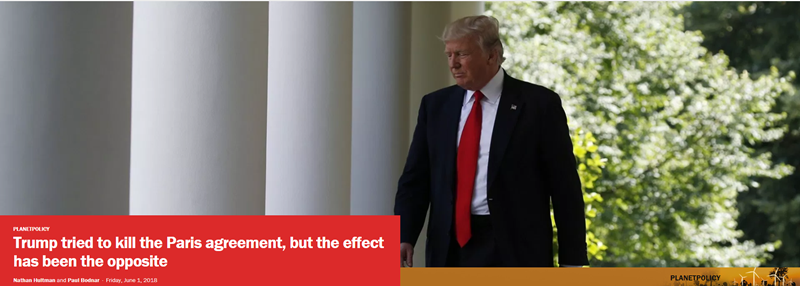
Trump tried to kill the Paris agreement, but the effect has been the opposite
Nathan Hultman & Paul Bodnar
Friday, June 1, 2018
One year ago, President Donald Trump announced his intent to withdraw the United States from the Paris agreement on climate change. This international accord, reached after a decade of multilateral negotiation and considerable U.S. leadership, represented a new and flexible global approach to climate action that respects individual nations’ priorities while encouraging all countries to move toward a cleaner economy. If Trump thought his decision would cripple the Paris agreement and global momentum on climate action, the reality one year later looks quite different.
First, America’s governors, mayors, and CEOs immediately stepped into the breach. Within hours of Trump’s announcement, an unprecedented coalition—now numbering over 2,700 states, cities, and businesses—rallied behind the Paris agreement under the banner “We Are Still In.” This coalition is globally significant, equivalent in size to the world’s third-largest economy, and made its voice heard at the U.N. climate talks by setting up the largest U.S. presence ever at a global climate meeting. As the America’s Pledge on Climate initiative—led by Michael Bloomberg and Jerry Brown—has estimated, more than half of Americans now live in a state or city or work for a business that has committed to driving down its carbon pollution and building a clean energy economy in line with goals to stabilize climate and improve health. For example, states accounting for 35 percent of the U.S. economy will institute a carbon pricing policy by the end of 2018. Eighty-four cities and counties have committed to 100 percent renewable energy. And over 100 companies globally, including 25 in the U.S., have announced their own emissions reduction targets in line with the Paris agreement.
Second, the world has rallied around the Paris agreement itself. Both large and small countries have since stated their intention to see the agreement succeed, linking its success to both global needs and to their own domestic priorities for cleaner air, health, and jobs. Just weeks after Trump’s announcement, the other 19 members of the G-20—including countries diverse as China, Japan, Saudi Arabia, and Germany—took the highly unusual step of closing ranks to declare that Paris was “irreversible” regardless of the Trump administration’s view. By the fall, Nicaragua and Syria became the last two countries in the world to sign the agreement—an unusual degree of global consensus for any multilateral accord.
Third, the shift away from carbon pollution and toward clean energy in the U.S. has continued to accelerate, even since the presidential election. Previous U.S. policies and surprisingly high rates of technological innovation have created an explosion of new opportunities for modern and clean energy sources that can go hand-in-hand with strong economic growth. As a result, U.S. carbon emissions continued to fall through 2017, hitting their lowest level in 25 years. The International Energy Agency estimates that solar photovoltaic module costs dropped by around 80 percent in the six years to 2016, and that by 2020, electricity from renewables will be cheaper than most fossil fuels. Already, in many regions, it is now cheaper to build new renewable energy capacity than new fossil energy. Since 2016, nearly every forecast for electric vehicle growth has increased dramatically as costs have dropped and consumer demand increased. Bloomberg New Energy Finance projects that 27 million electric vehicles will be on U.S. roads by 2030. In the year since Trump’s announcement, the U.S. has added more than 9 gigawatts of renewable electricity capacity—enough to power more than 2 million homes each year. In the first two months of 2018 alone, we added 2.1 gigawatts of wind and solar. Meanwhile, the pace at which coal fired power plants have announced shutdowns has actually increased since 2016.
While federal leadership is sorely needed to combat the climate crisis, American climate leadership remains alive and well. And this new kind of leadership—bottom up, driven by the conviction of citizens, the leadership of cities, states, and businesses, and the innovative capacity of our private sector—is not only delivering real action today, but also laying the groundwork for a sustained future partnership with the federal government.


































